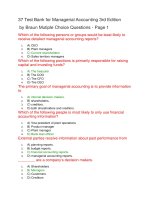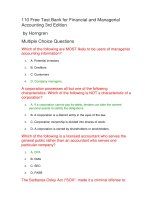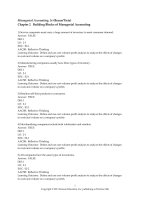Financial managerial accounting 3rd kieso ch16 (process costing)
Bạn đang xem bản rút gọn của tài liệu. Xem và tải ngay bản đầy đủ của tài liệu tại đây (603.7 KB, 15 trang )
Financial & Managerial Accounting
rd
3 Edition
Weygandt Kimmel Kieso
Chapter 16
Process Costing
Chapter Outline
Learning Objectives
LO 1
Discuss the uses of a process cost system and how it compares to a job order system.
LO 2
Explain the flow of costs in a process cost system and the journal entries to assign
manufacturing costs.
LO 3
Compute equivalent units.
LO 4
Complete the four steps to prepare a production cost report.
Copyright ©2018 John Wiley & Son, Inc.
2
Overview of Process Cost System
Uses of Process Cost Systems (1 of 3)
To apply costs to similar products that are mass-produced in a continuous fashion.
Examples include the production of Cereal, Paint, Manufacturing Steel, Oil Refining and
Soft Drinks.
ILLUSTRATION 16.1
Manufacturing processes
Copyright ©2018 John Wiley & Son, Inc.
3
Uses of Process Cost Systems (2 of 3)
ILLUSTRATION 16.2
Process cost and job order cost companies and products
Copyright ©2018 John Wiley & Son, Inc.
4
Uses of Process Cost Systems (3 of 3)
Which of the following items is not a characteristic of a process cost system:
a.
Once production begins, it continues until the finished product emerges.
b.
The focus is on continually producing homogenous products.
c.
When the finished product emerges, all units have precisely the same amount of materials,
labor, and overhead.
d.
The products produced are heterogeneous in nature.
Copyright ©2018 John Wiley & Son, Inc.
5
Process Cost for Service Companies
Service companies that provide individualized, nonroutine services will probably benefit
from using a job order cost system.
Those that perform routine, repetitive services will probably be better off with a process cost
system.
Copyright ©2018 John Wiley & Son, Inc.
6
Similarities and Differences Between Job Order Cost and Process Cost
Systems
Job Order Cost
Process Cost
•
Costs assigned to each job.
•
•
Products have unique characteristics.
Costs tracked through a series of
manufacturing processes or departments.
•
Products are uniform or relatively
homogeneous and produced in a large
volume.
Copyright ©2018 John Wiley & Son, Inc.
7
Job Order Cost and Process Cost Flow (1 of 3)
ILLUSTRATION 16.3
Job order cost and process cost flow
Copyright ©2018 John Wiley & Son, Inc.
8
Job Order Cost and Process Cost Flow (2 of 3)
Similarities
Differences
1.
Manufacturing cost elements.
2.
Accumulation of the costs of materials,
3.
1.
Number of work in process accounts
used.
labor, and overhead.
2.
Documents used to track costs.
Flow of costs.
3.
Point at which costs are totaled.
4.
Unit cost computations.
Copyright ©2018 John Wiley & Son, Inc.
9
Job Order Cost and Process Cost Flow (3 of 3)
ILLUSTRATION 16.4
Job order versus process cost systems
Copyright ©2018 John Wiley & Son, Inc.
10
DO IT! 1 Job Order and Process Cost
Indicate whether the following are true or false.
False
True
1.
A law firm is likely to use process costing for major lawsuits.
2.
A manufacturer of paintballs is likely to use process costing.
3.
Both job order and process costing determine product costs at the end of a period
of time, rather than when a product is completed.
False
4.
Process costing does not keep track of manufacturing overhead.
False
Copyright ©2018 John Wiley & Son, Inc.
11
Process Cost Flow and Assigning Costs
Process Cost Flow (2 of 2)
Tyler Company manufactures roller blade and skateboard wheels that it sells to
manufactures and retail outlets. Manufacturing consists of two processes: machining and
assembly. The Machining Department shapes, hones, and drills the raw materials. The
Assembly Department assembles and packages the wheels.
Copyright ©2018 John Wiley & Son, Inc.
12
Process Cost Flow (2 of 2)
ILLUSTRATION 16.5
Flow of costs in process cost system
Copyright ©2018 John Wiley & Son, Inc.
13
Assigning Manufacturing Costs
Accumulation of cost of materials, labor, and overhead is same as in job order costing.
.
Debit Raw Materials Inventory for purchases of raw materials.
.
Debit Factory Labor for factory labor incurred.
.
Debit Manufacturing Overhead for overhead cost incurred.
Assignment manufacturing costs to WIP in process cost is different than job order cost.
Copyright ©2018 John Wiley & Son, Inc.
14
Copyright
Copyright © 2018 John Wiley & Sons, Inc.
All rights reserved. Reproduction or translation of this work beyond that permitted in Section 117 of the 1976 United States Act without the express
written permission of the copyright owner is unlawful. Request for further information should be addressed to the Permissions Department, John Wiley &
Sons, Inc. The purchaser may make back-up copies for his/her own use only and not for distribution or resale. The Publisher assumes no responsibility for
errors, omissions, or damages, caused by the use of these programs or from the use of the information contained herein.
Copyright ©2018 John Wiley & Son, Inc.
15









